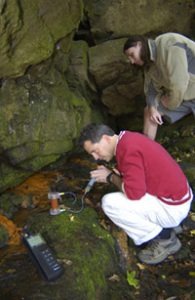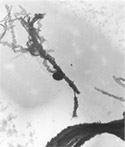UA Biologist Joins Search for Life on Mars; Rock-Eating Bacteria Could Hold Key
by Chris Bryant

Looking at rocks in Idaho might not be the first place that comes to mind in searching for clues to whether life exists on Mars, but that’s where The University of Alabama’s Dr. Eric Roden expects to begin his quest in November.
Roden, a professor of biological sciences at UA, is part of a national 10-member team awarded some $5 million from the NASA Astrobiology Institute to further study the possibility of life on Mars. UA will receive about $485,000, over five years, for Roden’s role in the effort, spearheaded by researchers at The University of California-Berkeley.
“We want to look at environments on earth that are analogous to near surface Martian environments,” Roden said.
“Somewhere under the surface of Mars, there could be liquid water,” said Roden. “In places where the liquid water approached the surface, there could be life — microbial life.”
And what would this life use as a food source? Mars’ red-tinted soil offers a clue. It’s the iron in the Martian soil that gives it its red color, said Roden. Certain “rock-eating” bacteria on earth are known to derive energy from oxidizing iron within rocks, known as andesites.
Scientists have learned that certain rocks — found in Oregon, Idaho, and Hawaii — contain minerals similar to those found near Mars’ surface.
“There is a very small amount of oxygen in the Martian atmosphere, less than .2 percent of its atmosphere,” Roden said. “Still, it’s there, and together with these iron minerals, it could permit life and could have permitted life in the past.”
Roden and a UA undergraduate student, Ryan St. John, plan to travel to Box Canyon Idaho in coming weeks to further study these rocks and to bring some back to Roden’s UA laboratory.
Samples would be placed in what Roden called an astro-bioreactor where biochemical analyses would be performed.
By better understanding how these microbes on earth use the iron as an energy source, clues can be obtained as to how similar types of microbial life could exist on Mars. The efforts could, the researchers said, also lead to methods of analysis that could later be used on rocks removed from Mars. The group’s overall effort is expected to impact decisions related to specific locations for future sampling of Mars’ rocks.
Roden expressed appreciation to UA’s School of Mines and Energy Development for its support of an earlier project that generated seed money and helped attract the latest funding.
“We’re not saying we’re going to discover whether there is life on Mars,” Roden said of the project. A goal of the project is to attract the next generation of researchers with expertise in geology and microbiology, and Roden said he’s pleased to have St. John intricately involved as he’s part of that next generation.
Roden’s initial foray into the study of iron mineral breathing microbes came a bit closer to home, in the swamps of the Talladega National Forest. This is his first space-related research project.
“It’s fun to think about,” Roden said. “Sooner or later, no doubt, a geo-microbiologist will go to Mars.”
Further Reading



